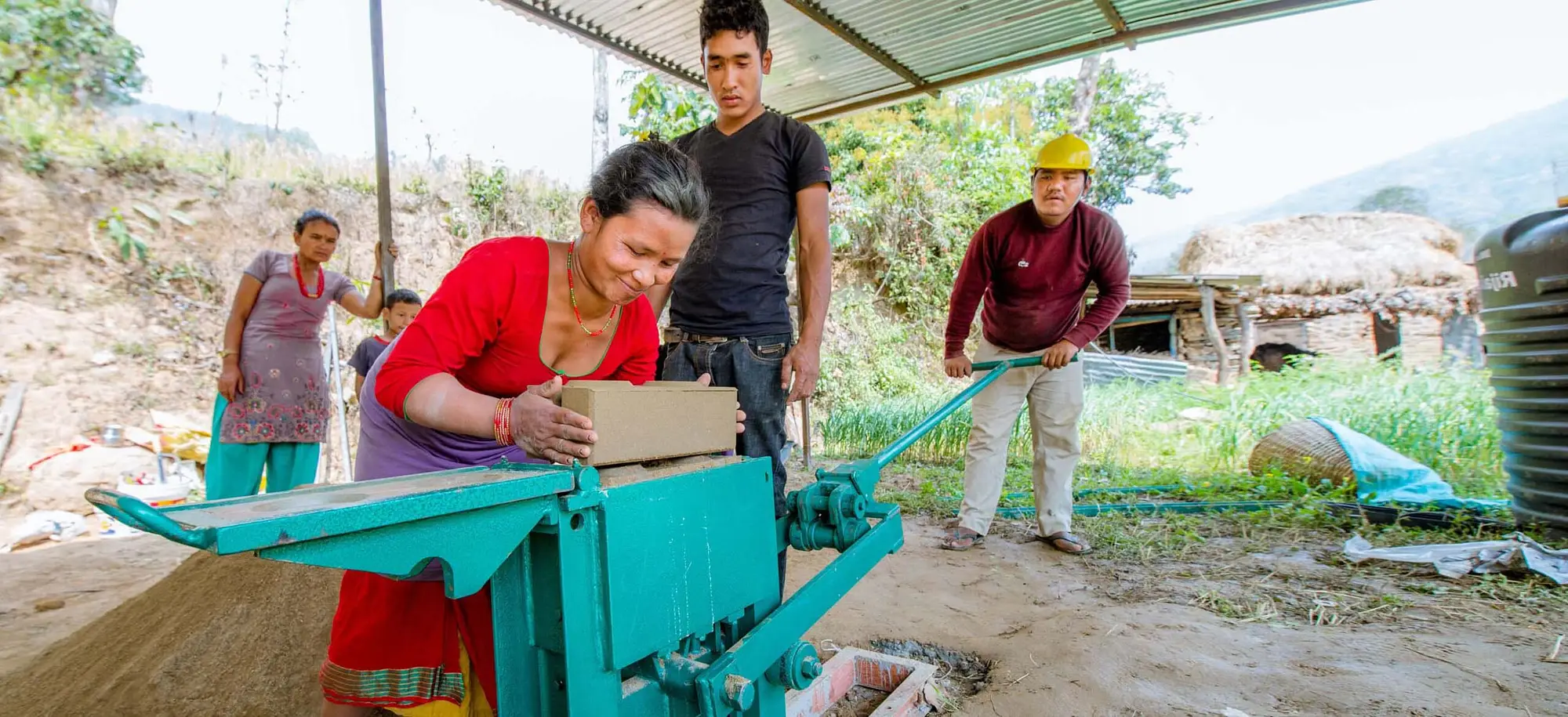Build safer, eco-friendly housing and improve economic opportunity
Lesson Learned:
Innovations in how we build housing can help mitigate the harm of future natural disasters, be a new source of livelihoods for those previously left out, and improve the economies of affected communities
Around the world, climate- and weather-related disasters have been rising in both incidence and severity. With its steep terrain and heavy monsoons, Nepal is an example of a particularly vulnerable country.[1] For example, in 2015, Nepal experienced an earthquake that destroyed 866,207 houses and then two years later, floods led to the destruction of an additional 43,400 houses.[2] These events hit Nepal particularly hard because of a preexisting lack of stable housing infrastructure that leaves up to one-third of families living in informal settlements.[3]
Build Up Nepal works with local entrepreneurs in rural Nepal to rebuild safe, affordable, and eco-friendly housing using interlocking Compressed Stabilized Earth Bricks (CSEBs).
“I am now able to give employment opportunities to my nearby friends. These women were unemployed before, I feel happy to give them jobs and work nearby their homes.”
– a female entrepreneur CSEB brickmaker

What it does
In many parts of the world, traditional brick is the predominant regional building material, but brick kilns are powered by low-grade coal, adding to the climate crisis that contributes to disasters. In Nepal, building materials, including fired bricks, alone are responsible for 37% of Nepal’s CO2 emissions.[4]
In contrast, Build Up Nepal’s CSEBs are made from recycled stone dust — readily available waste from stone crushers even in remote and rural settings. Compared to fired brick, walls built from CSEBs produced 50%-80% less CO2 emissions and cost 35%-50% less.
Build Up Nepal recruits potential entrepreneurs in rural communities, with particular focus on reaching women and people who may not be able to make a steady income. The organization sells the CSEB machines to entrepreneurs at an affordable price and trains the entrepreneurs in machine use and business development. Build Up Nepal’s staff (95% of whom are from Nepal) offer trainings, typically at a housing construction site, to teach entrepreneurs how to produce bricks, ensure quality, and run a business enterprise that produces safe, cost-effective houses. Build Up Nepal continues to support business owners by providing ancillary training, machine maintenance, and connecting entrepreneurs to potential work. The organization continues to monitor and evaluate the quality of the houses constructed.
How effective it is
Since the 2015 earthquake in Nepal, Build Up Nepal has trained 306 micro-enterprises to build 8,120 houses and create 3,170 jobs. Over half of the micro-enterprises the organization has cultivated belong to disadvantaged groups, including Dalit (the lowest caste) and Indigenous people.
Internal data show over 90% of the jobs created are held by youth, women, and people previously living on less than $1.90 a day. The average salary of the CSEB brickmaker is NPR 17,250 ($133 USD) per month, or $4.30 a day — a 2.25x increase over the minimum livable income in Nepal.
On average, entrepreneur enterprises working with Build Up Nepal build 15 low-cost houses a year, create 10-12 jobs in their local village, and save 70 tons of CO2 emissions. Additionally, Build Up Nepal has saved over 74,227 tons of CO2 emissions to date through the creation of its CSEBs — as much as is produced by 15,000 cars in a year. The organization has trained more than 300 teams internationally in CSEB production and 1,200 masons in construction with the bricks, broadening its impact beyond Nepal.
How philanthropy helps
Build Up Nepal earns 80% of its funding through their own sales and 20% from philanthropic contributions. Philanthropic funds allow the organization to provide systematic quality control to ensure houses are built safely and provide additional support and training to entrepreneurs from disadvantaged communities. Learn more at https://www.buildupnepal.com/.
More ways to help
Donors can preserve the environment while improving the livelihoods of fishing communities by supporting National Geographic Pristine Seas, which works to restore the health and productivity of the ocean. Find more ways to address climate disasters through better rebuilding and risk mitigation at CHIP’s Phases of Disaster Relief.
Notes
[1] World Bank Group. (2021). World Bank Climate Change Knowledge Portal. https://climateknowledgeportal.worldbank.org/
[2] National Reconstruction Authority of Nepal. (2023). National Reconstruction Authority. http://www.nra.gov.np/en/mapdistrict/datavisualization
[3]Nepal Planning Commission. (2018). Multidimensional Poverty Index. https://www.npc.gov.np/images/category/Nepal_MPI.pdf
[4] Eil, A., Li, J., Baral, P., & Saikawa, E. (2020). Dirty Stacks, High Stakes. World Bank. https://doi.org/10.1596/33727
